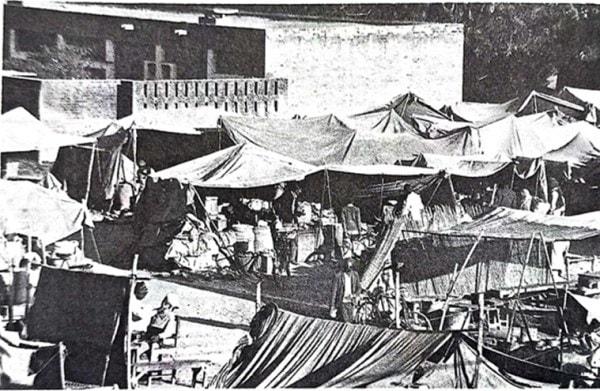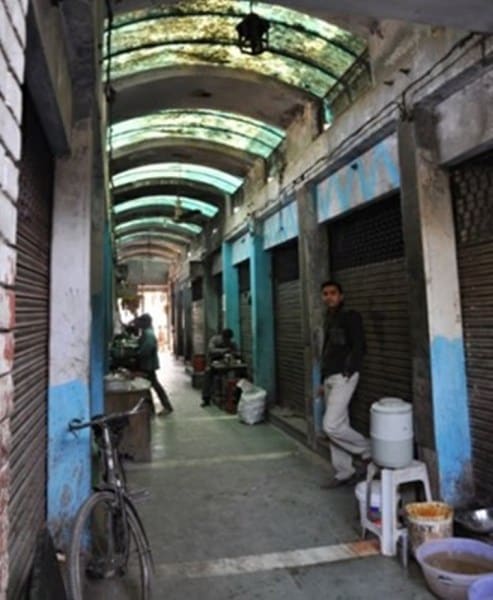Updated: February 20, 2022 12:03:43 pm
 Rural migrants selling vegetables from rented Rehris (Source: Madhu Sarin, Urban planning in the Third World: The Chandigarh Experience)
Rural migrants selling vegetables from rented Rehris (Source: Madhu Sarin, Urban planning in the Third World: The Chandigarh Experience) (Written by Astha)
Market places are one of the most vital components of a city’s public realm. In urban areas, apart from the regulated formal markets, informal markets and hawkers provide easy access to goods and services as well as create a unique character for the urban fabric.
Informal markets also play an important role in the pecuniary build-up process. In Chandigarh, the layout of the Sector Market was designed to accommodate commercial establishments of various economic categories and included a variety of built forms, in terms of scale, typology and trade.
Informal markets started even before the construction of this city had commenced. Many people started migrating here as the word spread that a new city was going to be built. The demand for basic goods and services, by the technical staff and construction labour who had to reside at the site in the early years, offered bright prospects for starting small-scale enterprises requiring little investment. Bajwada, the village southwest of Sector 22, responded to their essential needs such as cloth, household goods, repairing services and some typical traditional items such as charpoys and tin trunks.
Alongside Bajwada, other forms of informal commercial and service activities had been growing at several locations in the city. As the low-income population of Sectors 22 and 23 grew, many hawkers started congregating either near the fast-developing planned shopping streets or open spaces adjacent to high-density residential areas. Such locations started functioning as informal markets and became focal points for attracting large numbers of customers and sellers.
As the planned development hastened, the continued growth in the number of Rehris, Patris and Khokhas became a cause of alarm for the CPO. The entire problem was examined in detail in 1959 and the capital project authorities earmarked certain places in the city for the parking of Rehris (wheelcarts). With the first hand-cart bylaws, a system of issuing licenses for Rehris at nominal annual fees were also introduced, and the parking of Rehris anywhere but the authorised sites was forbidden.
Unable to control the growth of Rehris by other means, the authorities in 1969 unanimously decided to abolish the plying of Rehris altogether. It also recommended that the senior town planner and chief architect should find suitable areas in various sectors where cheap sheds could be built and leased to the already licensed rehriwallas.
 Rehri market in Sector 22 before the allotment of permanent booths
Rehri market in Sector 22 before the allotment of permanent booths(Source: Madhu Sarin, Urban planning in the Third World: The Chandigarh Experience)
The original planners of the city probably could not foresee the exponential growth of the informal commercial activity which goes alongside the formal shopping areas in present-day Chandigarh. Though the plan of the neighbourhoods provided for booths, they were beyond the reach of the ordinary rehriwala.
The number of Rehris might have been much larger but for the in situ upgrade by the Chandigarh administration which provided nearly three thousand mini-booths permanent structures in the form of Rehri markets across the city.
The Rehri markets are now replaced by pucca, box-like structures. A scheme namely- allotment/transfer of built-up booths in Chandigarh 1993 was extended to various sectors of phase-I and phase-II.
 Walkway in Booth marker, Sector 20, Chandigarh
Walkway in Booth marker, Sector 20, Chandigarh(Source: agingmodernism.wordpress.com)
Booths began as temporary structures, filling in vacant space with 8’x8’ sheds for smaller merchants, those either without means for a whole shop or with less merchandise. There are many variations of the booth. Some, like those in Sector 24 are still makeshift bamboo structures with aluminium or plastic cladding. Others are more developed, and some Sectors (15, 20 and 22) hold whole booth markets, for which architects were involved.
The Patel Market in Sector 15 is a huge booth complex, started around 1965 as a bunch of stationary Rehris under a cluster of existing trees near the NW end of the V4. In 1992, these temporary, mobile structures were converted into permanent booths. The structure of the booth is made with load-bearing brick walls roofed with a concrete pyramid.
The booth market in Sector 20 is a designed variation in which the walkway is a ventilated barrel vault with booths on either side. Verka booths deliver dairy products to residents and are scattered as stand-alone booths throughout the city.
 Walkway in Booth marker, Sector 20, Chandigarh
Walkway in Booth marker, Sector 20, Chandigarh(Source: agingmodernism.wordpress.com)
Booth markets, though catering to the needs of a large chunk of the city’s population, are a sore point as far as the city’s architectural character is concerned. A considerable number of shops in the market are encroaching upon the corridors with their products and display areas.
Also, many hawkers have established their territory on the pavement, and this has led to reduced pedestrian movement areas. These encroachments have increased the chances of fire hazards.
Unhygienic conditions have been caused by a lack of proper drainage and collection of litter and waste from vegetables, fruits and other eatables. All these problems arise when there is a lack acceptance of informal markets as a proper institution.
Even though the Chandigarh administration, concerned about the dishevelled appearance of its markets, has put in a lot of effort into legalising and revamping the temporary situation, informal markets and peddlers have always been a part of the Indian market culture and cannot be wished away through visionary policies of ‘Chandigarh-The City Beautiful’. Accepting their existence and considering them for city development planning may well be the answer.
The author is a visiting faculty in Chandigarh College of Architecture. The article is edited by Saumya Sharma, Assistant Professor, Chandigarh College of Architecture. It is part of the series of fortnightly articles by students and faculty of CCA on the Making of Chandigarh for the LCPJ forum.
- The Indian Express website has been rated GREEN for its credibility and trustworthiness by Newsguard, a global service that rates news sources for their journalistic standards.

